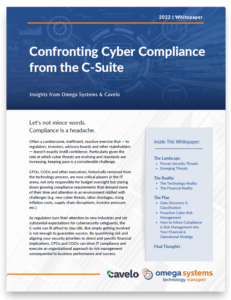

Read Omega and Cavelo’s whitepaper, Confronting Cyber Compliance from the C-Suite, to learn more about:
Complete the form to read the full whitepaper or keep scrolling to read a brief excerpt and learn more about the IT compliance management — and the technology and financial implications associated with non-compliance.
Before financial and operational executives gather their IT teams and/or MSP and MSSP resources for compliance strategy sessions, let’s consider a few realities that may be critically impacting your organization’s security and compliance effectiveness – whether you realize it or not.
Ask yourself:
Whether your organization has 20 endpoints or 20,000 – you’ll need to better understand the key complexities inherent in both the technology and financial realms that will impact how your organization answers the above questions – and how well you achieve effective cybersecurity compliance overall.
The technology world never stands still, and both business and IT leaders should consider the common hurdles and complexities contributing to failed or inefficient governance, risk and compliance (GRC) programs.
With the drastic increase in remote users, endpoints, and cloud applications, knowing where data resides is increasingly challenging. IT and security teams use a combination of processes and technologies to track digital assets (including hardware, software, cloud and sensitive data), and understand their business’s internal and external attack surface. However, legacy and disparate technologies can create data silos that limit visibility to the sensitive data a business has.
As if protecting more endpoints against more unique threats wasn’t enough of a challenge on its own, today’s enterprises are also attempting to do so with a crippling lack of IT talent. The labor shortage has left businesses with fewer resources to ward off threats and meet the growing demands for regulatory compliance – a concerning prospect for the C-suite.
Then there’s the increasing complexities associated with vendor risk management. The accessibility, efficiency and flexibility that cloud applications and outsourced services provide introduces further risk to an organization’s risk management and requires that businesses complete thorough vendor due diligence and employ ongoing evaluations to ensure critical data and systems remain safeguarded when accessed or managed by third parties.
Of course, if you’re sitting in a corner office or an executive boardroom, one significant question has been looming thus far: without writing a blank check, how can I possibly understand what’s required to safeguard our assets and achieve effective IT compliance?
IBM’s Cost of a Data Breach Report indicates the average global cost associated with a security breach rose 12.7 percent year-over-year to reach $4.35 million. That cost is even higher in certain highly targeted industries, such as healthcare and financial services.
The financial implications of cybersecurity incidents are likely to continue rising. With each incident, so increase the costs for:
In order for the C-suite to achieve transparency into the true cost of a breach at their organization, they must strive to quantify the unique risks and vulnerabilities inherent in their existing cybersecurity program.
Fortunately, that process is attainable.
The financial costs associated with a breach are ultimately determined by the value of the data accessed or stolen. If executives can first locate all of the so-called sensitive or confidential data across their endpoints (servers, devices, cloud applications, etc.) and organize them in a manner that applies direct value to their importance, suddenly a roadmap for cybersecurity risk mitigation, compliance and financial protection becomes clear.